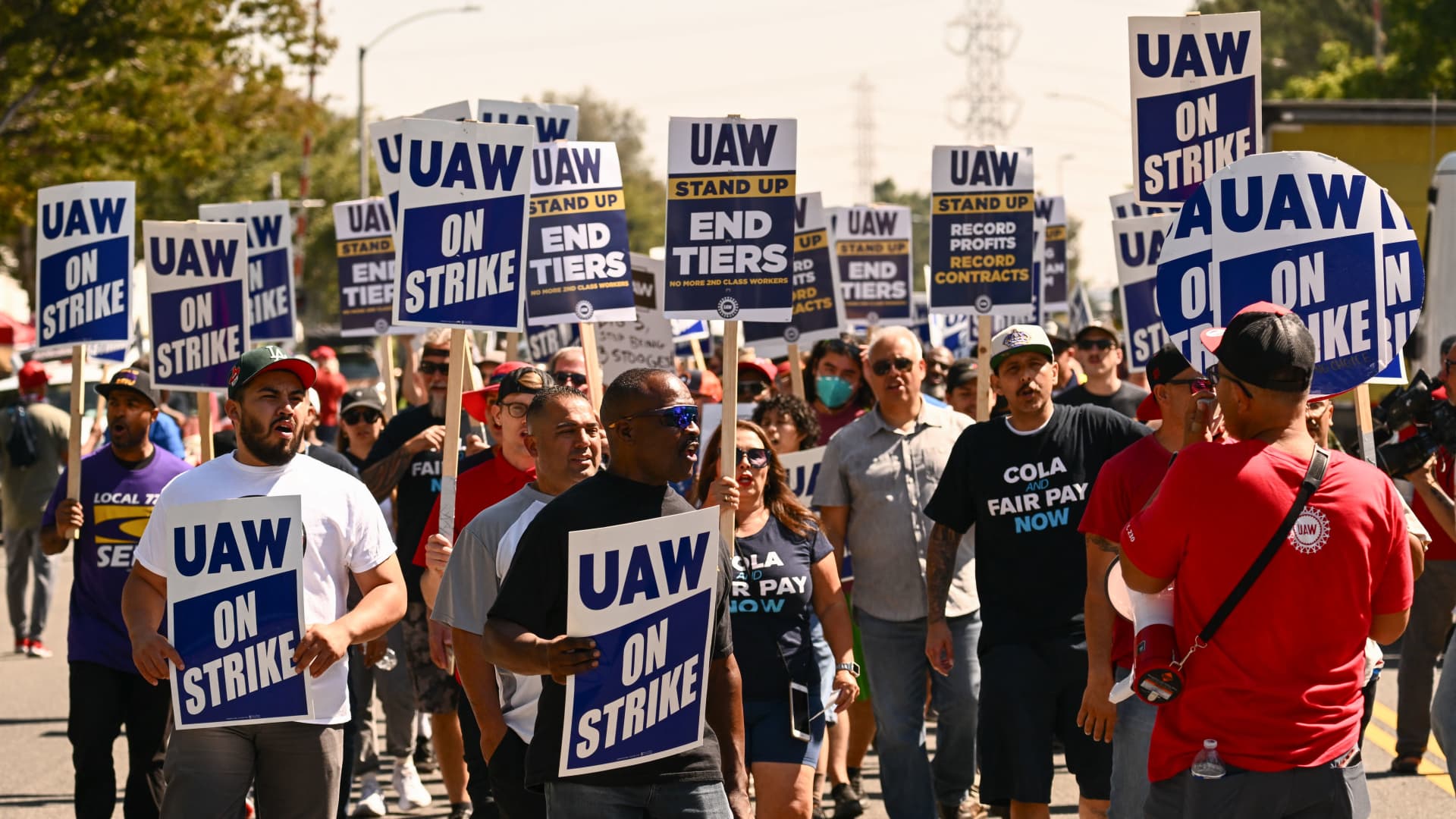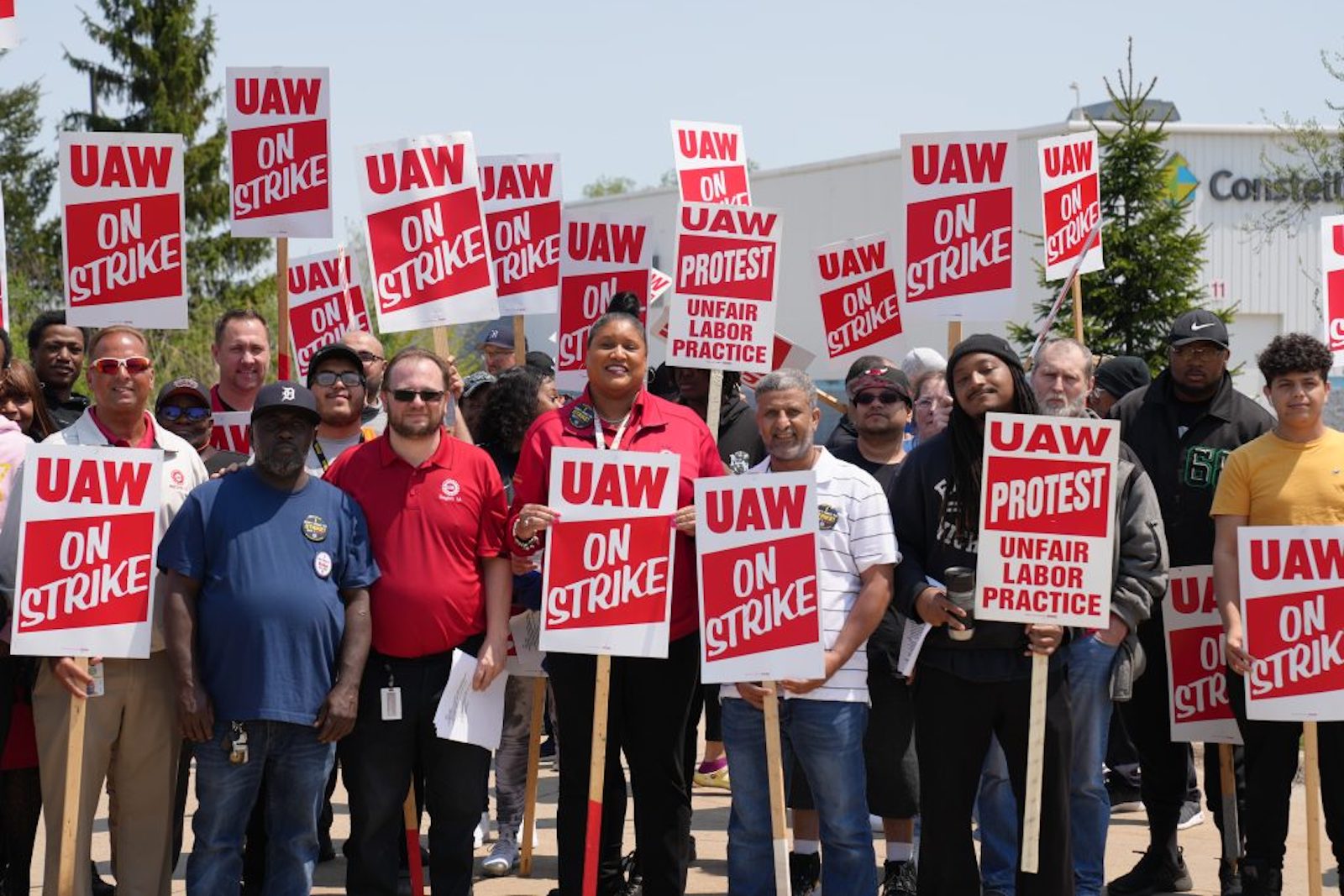When the UAW on strike, it’s not just another labor dispute—it’s a seismic shift that could redefine the automotive world. This isn’t your run-of-the-mill protest; it’s a battle for workers' rights, fair wages, and better working conditions. So, buckle up, because we’re diving deep into the nitty-gritty of what’s really going on.
Imagine this: thousands of workers standing united, demanding change. The UAW strike is more than just a negotiation—it’s a fight for the future of the American auto industry. With tensions running high and negotiations at a standstill, the stakes couldn’t be higher. So, what’s really driving this movement? Let’s break it down.
This article isn’t just about reporting facts; it’s about giving you the inside scoop on why the UAW on strike matters, how it affects the industry, and what it means for you. Whether you’re a worker, a car enthusiast, or just someone curious about the impact, this is the info you need.
Read also:Tony Ward Bridal Dresses The Ultimate Guide To Timeless Elegance
Table of Contents
- Introduction
- A Brief History of the UAW
- Why Is the UAW on Strike?
- Economic Impact of the Strike
- The Worker's Perspective
- Management’s Point of View
- Potential Solutions on the Horizon
- Global Effects of the UAW Strike
- The Future of the Auto Industry
- Conclusion: What’s Next?
A Brief History of the UAW
The UAW, or United Auto Workers, has been around since 1935. Yeah, it’s been a long journey. Originally formed to protect workers’ rights in the auto industry, it’s grown into one of the most powerful labor unions in the US. The UAW’s history is filled with landmark moments, from the famous sit-down strikes in the ‘30s to negotiating groundbreaking contracts that set industry standards.
But here’s the kicker: the UAW isn’t just about cars. It’s expanded its reach to include aerospace, agricultural equipment, and even tech workers. So, when the UAW on strike, it’s not just the auto industry that feels the ripple effects. It’s a domino effect that touches multiple sectors.
Key Milestones in UAW History
- 1937: The Flint Sit-Down Strike leads to the first major contract with General Motors.
- 1950: The “Treaty of Detroit” sets new standards for wages and benefits in the auto industry.
- 2009: The UAW plays a crucial role in the auto industry bailout during the financial crisis.
Why Is the UAW on Strike?
Let’s get real here. The UAW on strike because workers feel they’re being shortchanged. It’s not just about money—it’s about respect, job security, and fair treatment. Workers are demanding better wages, improved healthcare benefits, and a say in the transition to electric vehicles. With the auto industry shifting rapidly, many fear they’ll be left behind.
And let’s not forget the temp workers. A significant portion of the workforce is made up of temps who don’t get the same benefits as full-time employees. The UAW is pushing for equal treatment, arguing that these workers deserve the same rights and protections as their permanent counterparts.
Top Demands from the UAW
- Higher wages and cost-of-living adjustments.
- Improved healthcare benefits for all workers.
- Equal treatment for temporary and contract workers.
- A voice in the transition to electric vehicles.
Economic Impact of the Strike
When the UAW on strike, it hits the economy hard. Production halts, supply chains get disrupted, and the ripple effects spread far and wide. Automakers lose millions in revenue every day the strike continues. But it’s not just the big companies feeling the pain—small businesses that rely on the auto industry also take a hit.
And then there’s the consumer. Car prices could rise as manufacturers pass on the cost of the strike to buyers. It’s a vicious cycle that affects everyone from the factory floor to the dealership showroom. But hey, that’s the price of progress, right?
Read also:Unveiling The Life And Legacy Of R J Hughes A Journey Through Time
Key Economic Statistics
- Each day of the strike costs automakers approximately $100 million in lost revenue.
- Supply chain disruptions could lead to shortages of parts and materials.
- Car prices are expected to increase by 2-3% if the strike continues for an extended period.
The Worker's Perspective
Let’s hear it from the folks on the ground. For many UAW members, this strike is personal. They’ve dedicated their lives to the industry, only to see their jobs threatened by automation and outsourcing. It’s not just about money—it’s about pride and dignity. Workers feel they deserve a fair share of the profits they help generate.
One worker we spoke to said, “We’re not asking for the moon. We just want to be treated with respect and given a fair shot at a decent life.” That pretty much sums it up. The UAW on strike because workers believe they deserve better—and who can blame them?
Voices from the Frontline
- “The company is making record profits, but we’re still struggling to make ends meet.”
- “We want to be part of the conversation about the future of the industry, not just told what to do.”
- “It’s not just about us; it’s about setting a standard for workers everywhere.”
Management’s Point of View
On the other side of the table, automakers argue that they’re facing unprecedented challenges. The shift to electric vehicles requires massive investments, and they claim they can’t afford to meet all the UAW’s demands. They also point to global competition, saying they need to remain competitive in a rapidly changing market.
But here’s the thing: the companies are posting record profits. So, is it really about affordability, or is it about priorities? The UAW argues that the companies can afford to do more, and they have the numbers to back it up. It’s a classic case of conflicting interests, and finding common ground won’t be easy.
Management’s Key Arguments
- Investing in electric vehicles is crucial for long-term success.
- Global competition requires cost-cutting measures.
- Record profits are reinvested into the business, not just pocketed by executives.
Potential Solutions on the Horizon
So, what’s the way forward? Both sides need to compromise if they want to reach a resolution. The UAW might have to scale back some of its demands, while automakers need to show more willingness to meet workers halfway. Mediation could play a role, bringing in neutral parties to help facilitate negotiations.
Innovation could also be part of the solution. By investing in technology that benefits both workers and the company, they could find a win-win scenario. For example, retraining programs for workers transitioning to electric vehicle production could ease concerns about job security.
Possible Outcomes
- Compromise on wage increases and benefit packages.
- Investment in retraining programs for workers.
- Improved communication between workers and management.
Global Effects of the UAW Strike
The UAW on strike isn’t just a domestic issue—it has global implications. The auto industry is interconnected, and disruptions in one part of the world can have far-reaching effects. For example, automakers in other countries might see increased demand if U.S. production slows down. This could lead to shifts in market share and changes in global trade dynamics.
And let’s not forget the environmental impact. With the push for electric vehicles gaining momentum, any delays in production could hinder progress toward reducing carbon emissions. It’s a delicate balance between labor rights and environmental goals.
Global Trends to Watch
- Increased demand for vehicles from non-U.S. manufacturers.
- Shifts in market share and global trade patterns.
- Potential delays in the transition to electric vehicles.
The Future of the Auto Industry
So, where does this leave the auto industry? The UAW on strike is just one chapter in a much larger story. The industry is undergoing a transformation unlike anything we’ve seen before. Electric vehicles, autonomous driving, and advanced manufacturing technologies are reshaping the landscape. Workers need to adapt, and companies need to invest in their future.
But here’s the silver lining: this strike could lead to positive changes. By addressing workers’ concerns and investing in innovation, the industry could emerge stronger and more resilient. It’s a chance to redefine what the auto industry looks like in the 21st century.
Looking Ahead
- Increased focus on electric vehicle production.
- Investment in worker retraining and development programs.
- Potential for new labor agreements that set industry standards.
Conclusion: What’s Next?
As we wrap up this deep dive into the UAW on strike, it’s clear that this is more than just a labor dispute. It’s a pivotal moment for the auto industry, with far-reaching implications for workers, companies, and consumers. The outcome of this strike could set the tone for labor relations in the years to come.
So, what can you do? Stay informed, share your thoughts, and engage in the conversation. Whether you’re a worker, a car enthusiast, or just someone interested in the future of the industry, your voice matters. And hey, if you found this article helpful, don’t forget to leave a comment or share it with your friends. Let’s keep the conversation going!
References: - U.S. Bureau of Labor Statistics - National Bureau of Economic Research - The New York Times


